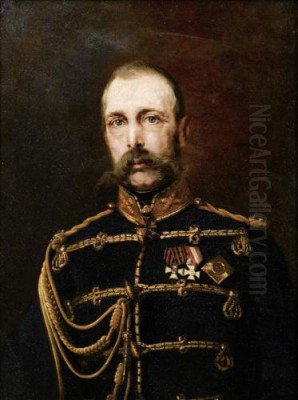
Konstantin Egorovich Makovsky stands as a significant, albeit complex, figure in the landscape of 19th and early 20th-century Russian art. Renowned primarily for his grand historical canvases and elegant portraits, Makovsky navigated the shifting artistic currents of his time, moving from the socially conscious realism of the Peredvizhniki (Wanderers) movement towards a more decorative, aesthetically driven style that celebrated an idealized vision of Russia's past. His life and work reflect both the aspirations and the contradictions of Russian society during a period of profound change. He achieved immense popularity during his lifetime, yet his legacy remains a subject of discussion among art historians, balancing his undeniable technical skill and visual appeal against criticisms of superficiality.
An Artistic Dynasty: Early Life and Influences
Konstantin Makovsky was born in Moscow on June 20 (July 2, New Style), 1839, into a family deeply immersed in the arts. His father, Yegor Ivanovich Makovsky, was a notable figure in Moscow's art circles – an accountant by profession but an amateur painter and an avid art collector. Crucially, Yegor Makovsky was one of the founders of the Moscow School of Painting, Sculpture, and Architecture in 1832, the very institution where Konstantin would later receive his foundational training. His mother, Lubov Kornilievna Makovskaya (née Mollengauer), was a composer and singer, adding a musical dimension to the household's creative atmosphere.
This environment proved exceptionally fertile. Konstantin was not the only Makovsky child to pursue an artistic path; his younger brothers, Vladimir and Nikolai, also became prominent painters, while his sister Alexandra became an artist as well. Vladimir Makovsky, in particular, would become a leading figure in the Peredvizhniki movement, often focusing on genre scenes depicting the lives of ordinary Russians, providing an interesting contrast to Konstantin's later focus on historical grandeur and aristocratic life. The Makovsky home was a hub for artists, writers, and musicians, exposing the young Konstantin to figures like the writer Nikolai Gogol and the painter Vasily Tropinin from an early age.
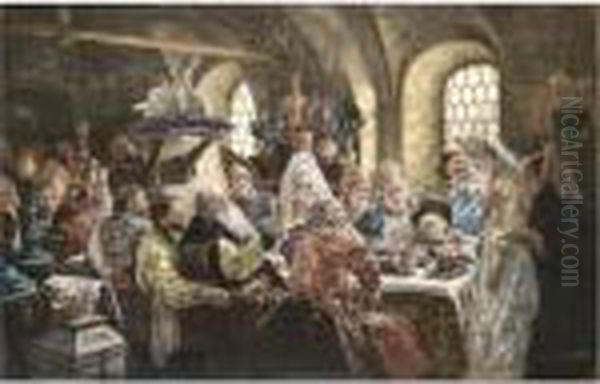
Vasily Tropinin, a celebrated portraitist known for his sensitive depictions, was an early mentor figure and friend of the family. His influence, emphasizing careful observation and a sympathetic portrayal of the sitter, likely played a role in shaping Konstantin's early approach to art. Another towering figure whose shadow loomed large was Karl Bryullov, the master of Russian Romantic historical painting. Though Bryullov died when Konstantin was young, his monumental canvases, particularly The Last Day of Pompeii, were iconic, and his emphasis on dramatic composition, rich color, and historical spectacle undoubtedly left a lasting impression on the aspiring artist.
Formal Training and Early Success
In 1851, at the age of twelve, Konstantin Makovsky formally enrolled in the Moscow School of Painting, Sculpture, and Architecture, the institution his father had helped establish. He quickly distinguished himself as a highly talented and diligent student, consistently earning accolades and awards. He studied under instructors like Mikhail Scotti and Sergey Zaryanko, absorbing the principles of academic drawing and painting. His training emphasized meticulous draftsmanship, anatomical accuracy, and the traditional hierarchy of genres, with historical painting considered the pinnacle of artistic achievement.
During his seven years at the Moscow School, Makovsky demonstrated exceptional promise. His student works already hinted at his facility with composition and his burgeoning interest in historical themes. He absorbed the prevailing influences of the time, including the lingering Romanticism inherited from Bryullov and the growing interest in realism that was beginning to challenge academic conventions across Europe. His early works from this period, while adhering to academic standards, showed a natural flair for capturing textures and a sensitivity to light and color.
The Moscow School provided a solid foundation, but the ultimate goal for ambitious Russian artists was the Imperial Academy of Arts in St. Petersburg, the nation's premier art institution. In 1858, having completed his studies in Moscow, Makovsky moved to the imperial capital to continue his education at the Academy. This move marked a significant step, placing him at the center of Russia's official art world and exposing him to new influences and rivalries.
The Imperial Academy and the "Revolt of the Fourteen"
At the Imperial Academy of Arts, Makovsky continued to excel. He studied under professors like Alexey Markov and Fyodor Bruni, figures steeped in the Neoclassical and late Romantic traditions favored by the Academy. He participated in the Academy's competitions, aiming for the coveted Gold Medal, which awarded a fellowship for study abroad, typically in Italy. His talent was recognized, and he received several awards during his time there, including a minor gold medal in 1862 for his painting Agents of the False Dmitry kill the son of Boris Godunov.
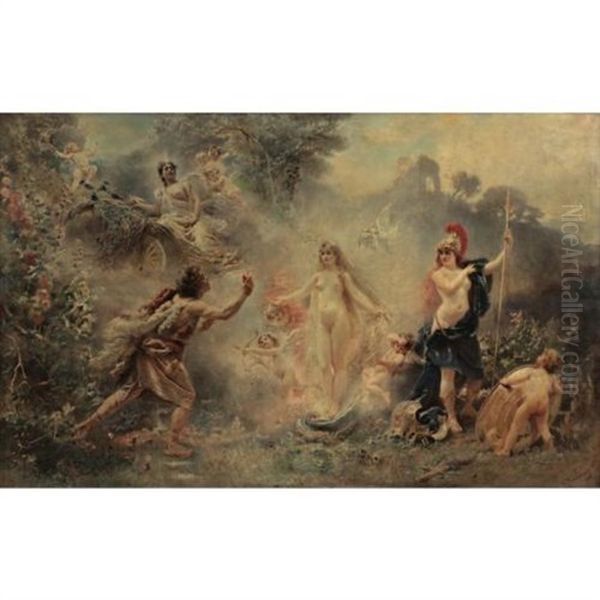
However, the Academy in the early 1860s was becoming a site of tension between established tradition and emerging artistic ideas. A younger generation of artists, influenced by democratic ideals and the rise of realism, began to question the Academy's rigid curriculum and its emphasis on mythological and historical subjects detached from contemporary Russian life. This simmering discontent came to a head in 1863 in an event known as the "Revolt of the Fourteen."
The Academy dictated the theme for the final Gold Medal competition: "The Feast of Odin in Valhalla." Fourteen top students, including the talented Ivan Kramskoi, petitioned the Academy Council to allow them to choose their own subjects, reflecting their desire to engage with more relevant themes. When the Council refused, the fourteen students, Makovsky among them, dramatically walked out of the competition and resigned from the Academy, forfeiting their chance at the prestigious fellowship.
While Makovsky participated in this protest, his motivations and subsequent path differed somewhat from the core group led by Kramskoi. The "Revolt of the Fourteen" was a pivotal moment, leading directly to the formation of the Artel of Artists, a cooperative commune, and later laying the groundwork for the Society for Travelling Art Exhibitions (Peredvizhniki). Makovsky, however, did not join the Artel. Although he shared the desire for greater artistic freedom, his own inclinations were perhaps less radically aligned with the social critique that would come to define the Peredvizhniki. He received an academician title later for his work The Poor Children (1865), indicating he did not completely sever ties with the academic system.
The Peredvizhniki and Shifting Allegiances
In 1870, the Society for Travelling Art Exhibitions (Tovarishchestvo peredvizhnykh khudozhestvennykh vystavok), commonly known as the Peredvizhniki or Wanderers, was officially founded. This group, emerging from the spirit of the 1863 revolt and the Artel, aimed to bring art to the people by organizing exhibitions that travelled throughout the Russian provinces. They championed realism, nationalism, and often focused on depicting the lives, struggles, and landscapes of Russia, frequently with a critical social edge. Key figures included Ivan Kramskoi, Ilya Repin, Vasily Perov, Nikolai Ge, and Konstantin's own brother, Vladimir Makovsky.
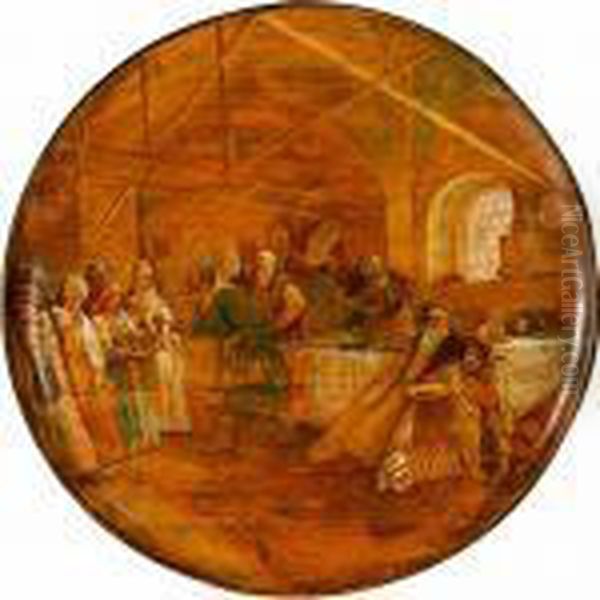
Konstantin Makovsky was a founding member of the Peredvizhniki and participated in their early exhibitions. Works from this period, such as Visiting the Poor and genre scenes like Children Running from a Thunderstorm (1872), align with the movement's interest in contemporary Russian life and social themes. His technical skill was undeniable, and his contributions added prestige to the fledgling society. He brought a level of painterly finesse and a sense for composition that was highly valued.
However, Makovsky's artistic temperament and ambitions gradually diverged from the core tenets of the Peredvizhniki. While many Wanderers focused on critical realism, exposing social injustices or celebrating the resilience of the common people, Makovsky found himself increasingly drawn to the aesthetic and decorative aspects of painting. He possessed a natural inclination towards vibrant color, rich textures, and visually appealing subjects. His travels abroad in the mid-1870s, particularly to Egypt and Serbia, further shifted his focus. These journeys exposed him to exotic locales, brilliant light, and different cultural aesthetics, reinforcing his interest in color and form over narrative or social commentary.
By the 1880s, Makovsky had largely distanced himself from the Peredvizhniki's ideological core, though he might still occasionally exhibit with them. His focus shifted decisively towards historical paintings depicting a romanticized vision of 17th-century Boyar Russia and towards lucrative society portraiture. This led to criticism from some within the Wanderers' circle, who felt he had abandoned the movement's progressive ideals in favor of commercially successful, aesthetically pleasing, but ultimately superficial art. The influential critic Vladimir Stasov, a staunch supporter of the Peredvizhniki's social mission, was particularly critical of Makovsky's later direction.
The Master of Historical Pageantry
It was in the realm of historical painting, particularly scenes from 17th-century Muscovy, that Konstantin Makovsky achieved his greatest fame and created his most iconic works. He developed a distinctive style characterized by dazzling color, meticulous attention to detail in costumes and settings, and large, complex compositions teeming with figures. These paintings were less about historical accuracy in a strict sense and more about evoking a sense of opulent, bygone splendor – a romanticized vision of pre-Petrine Russia before the Westernizing reforms of Peter the Great.

His most celebrated work in this genre is A Boyar Wedding Feast (1883). This enormous canvas depicts a lavish wedding celebration among the Boyar aristocracy. The scene is filled with intricate details: the rich brocades and furs of the costumes, the gleaming silver and gold tableware, the elaborate carvings of the wooden interior, the array of traditional foods. Makovsky masterfully orchestrates the numerous figures, capturing a range of expressions and interactions within the bustling scene. The painting is a tour de force of texture, color, and light, creating an immersive, almost theatrical experience for the viewer. It became immensely popular, embodying a nostalgic fascination with Russia's past that resonated with contemporary audiences.
Another key work is The Russian Bride's Attire (also known as Beneath the Crown), painted in 1889. Similar in theme and style to the Boyar Wedding Feast, it focuses on the ritual of dressing a young bride from a wealthy Boyar family. Again, Makovsky revels in the depiction of luxurious fabrics – silks, velvets, pearls – and the elaborate traditional headdress (kokoshnik). The painting emphasizes beauty, tradition, and wealth, presenting an idealized image of femininity and aristocratic custom. These works cemented Makovsky's reputation as a master of the historical genre, albeit one focused on spectacle rather than historical analysis or social commentary, unlike contemporaries such as Vasily Surikov, whose historical canvases like The Morning of the Streltsy Execution conveyed a much grimmer and more psychologically complex view of the past.
Makovsky's historical paintings were often meticulously researched in terms of material culture. He was an avid collector of Russian antiques – textiles, furniture, jewelry, household items – and frequently incorporated these objects into his paintings, lending them an air of authenticity, even if the overall mood was idealized. This attention to detail contributed significantly to their appeal and visual richness. Other notable historical works include Choosing the Bride for Tsar Alexei Mikhailovich (1886) and The Death of Ivan the Terrible. These paintings, while sometimes criticized for lacking psychological depth, were undeniably impressive displays of painterly skill and historical imagination.
The Society Portraitist
Alongside his historical epics, Konstantin Makovsky became one of the most sought-after and highly paid portrait painters in Russia. His ability to render likenesses accurately, combined with his flair for depicting luxurious fabrics and creating an aura of elegance and status, made him exceptionally popular among the aristocracy, wealthy merchants, and prominent figures of the cultural elite. His portraits, much like his historical scenes, often emphasized beauty, wealth, and social standing.
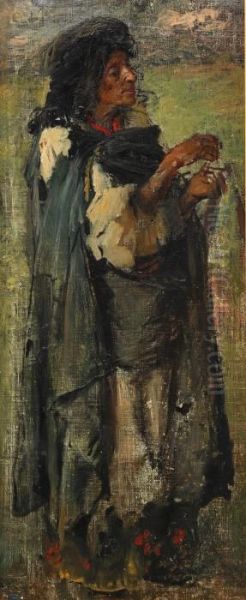
He painted numerous portraits of women, often depicted in lavish gowns, adorned with jewels, and set against opulent backgrounds. Works like Portrait of Countess Sophia Stroganova (1880s) or Portrait of Princess Zinaida Yusupova (1900s) exemplify his approach. He excelled at capturing the textures of silk, satin, velvet, and lace, and his use of color was often flattering and vibrant. While perhaps lacking the profound psychological insight found in the portraits of contemporaries like Ivan Kramskoi or later masters like Valentin Serov, Makovsky's portraits possessed an undeniable charm and visual appeal that perfectly suited the tastes of his clientele.
He also painted portraits of men, including members of the imperial family, fellow artists, and influential public figures. His self-portraits and portraits of his family members, such as In the Artist's Studio (1881), which depicts himself with his son Sergei and daughter Elena, offer more intimate glimpses, though still rendered with his characteristic attention to detail and rich color. His success as a portraitist brought him considerable wealth and solidified his position within the upper echelons of Russian society.
His style in portraiture, while rooted in academic tradition, also showed an awareness of contemporary European trends, particularly French Salon painting. The emphasis on elegance, technical polish, and flattering representation aligned well with the tastes of the international elite. Some critics argue that his focus on the superficial aspects of his sitters – their clothes, jewels, and status – came at the expense of deeper character exploration. However, his portraits remain valuable documents of the era's elite and showcase his considerable technical prowess.
Style, Technique, and Artistic Philosophy
Konstantin Makovsky's style evolved throughout his career, but certain characteristics remained constant. He possessed a remarkable technical facility, evident in his confident draftsmanship, his handling of complex compositions, and his mastery of rendering different textures. His color palette was typically rich and vibrant, often employing bold contrasts and a jewel-like intensity, particularly in his historical paintings and portraits of women. He had a keen eye for decorative detail, lavishing attention on costumes, interiors, and accessories.
His early work showed the influence of Romanticism (Bryullov) and the detailed realism favored by the Moscow School. His involvement with the Peredvizhniki saw him engage with genre scenes and social themes, executed with a relatively straightforward realism. However, the pivotal shift occurred in the 1870s and 1880s, following his travels and his growing success. He moved away from the critical realism and social engagement of the Wanderers towards what is often termed "Salon" or "Academic" art, prioritizing aesthetic appeal, historical pageantry, and decorative effect.

While sometimes labeled an Academic painter, Makovsky's work also displays elements that anticipate later movements. His vibrant color and increasingly free brushwork in some passages, particularly in studies or less formal works, have led some art historians to see him as a precursor to Russian Impressionism. His focus on light and color for their own sake, rather than purely for descriptive purposes, certainly distinguishes him from the more somber palettes of many of his Peredvizhniki contemporaries like Vasily Perov or Grigory Myasoyedov. However, he never fully embraced the Impressionist dissolution of form or its focus on fleeting moments of modern life.
Makovsky's artistic philosophy seemed centered on the pursuit of beauty, often equated with richness, historical grandeur, and idealized forms. He sought to create visually stunning canvases that transported the viewer, whether to a romanticized past or into the elegant world of the contemporary elite. While this approach brought him immense success and popularity, it also opened him to criticism for lacking depth and for catering to conventional tastes. He represented a strand of Russian art that valued aesthetic pleasure and historical nostalgia over the social critique and psychological exploration championed by others in his generation, such as Ilya Repin or Vasily Surikov.
Contemporaries and Artistic Milieu
Konstantin Makovsky operated within a vibrant and dynamic Russian art scene. His career spanned a period that saw the dominance of Academicism challenged by Realism, the rise of national consciousness in art, and the emergence of Symbolism and early modernism. Understanding his position requires seeing him in relation to his contemporaries.
His brother, Vladimir Makovsky, remained a stalwart of the Peredvizhniki, focusing on genre scenes that often carried subtle social commentary. Comparing their work highlights Konstantin's move towards a more decorative, less socially engaged art. Ivan Kramskoi, the intellectual leader of the early Peredvizhniki, was a master portraitist known for his psychological depth, offering a contrast to Konstantin's more outwardly focused portraits.
Ilya Repin, arguably the leading figure of Russian Realism, tackled major historical events (Ivan the Terrible and His Son Ivan) and contemporary social issues (Barge Haulers on the Volga) with an intensity and psychological power distinct from Makovsky's approach. Vasily Surikov specialized in large-scale historical canvases depicting pivotal moments in Russian history, often focusing on popular movements and dramatic conflicts, rendered with a rugged energy quite different from Makovsky's polished surfaces.
Among landscape painters, figures like Isaac Levitan captured the subtle moods of the Russian countryside, while Arkhip Kuindzhi experimented with dramatic effects of light. Towards the end of Makovsky's career, younger artists like Valentin Serov brought a fresh, almost Impressionistic immediacy to portraiture, while Mikhail Vrubel pioneered a unique Russian Symbolist style. Makovsky's work, particularly his later output, can be seen as representing the more conservative, albeit highly skilled and popular, wing of Russian art, standing apart from the stark realism of some Peredvizhniki and the emerging modernist trends.
Reception, Criticism, and Legacy
During his lifetime, Konstantin Makovsky was one of Russia's most celebrated and financially successful artists. His large historical paintings commanded enormous prices, and his portraits were highly sought after by the elite. He achieved international recognition, winning awards such as the Grand Gold Medal at the Exposition Universelle in Paris in 1889 for a collection of works including The Death of Ivan the Terrible, The Judgment of Paris, and Demon and Tamara. His studio was a lavish affair, reflecting his success and status.
However, his work also attracted significant criticism, particularly from those aligned with the Peredvizhniki's democratic and realist ideals. Critics like Vladimir Stasov accused him of sacrificing substance for effect, of creating beautiful but ultimately empty spectacles. They lamented his departure from socially relevant themes and his embrace of an idealized, aristocratic vision of Russia. His focus on the opulent 17th century was sometimes seen as escapist, ignoring the pressing issues of contemporary Russian society.
His legacy remains somewhat contested. On one hand, he is recognized as a painter of exceptional technical skill, a master colorist, and the creator of some of the most visually striking images in Russian art. His historical paintings, despite their idealization, played a role in shaping popular conceptions of Russia's past and remain highly popular with the public. His portraits offer valuable insights into the elite society of his time.
On the other hand, he is often seen as representing the limitations of Academic and Salon art – prioritizing surface beauty over deeper meaning, technical polish over emotional expression, and commercial appeal over artistic innovation or social commentary. Compared to the profound psychological depth of Repin, the epic historical drama of Surikov, or the spiritual intensity of Vrubel, Makovsky's work can appear less challenging and less enduringly significant in the grand narrative of Russian art history.
Nevertheless, his influence was felt. His success demonstrated the viability of a career outside the strictest confines of critical realism, and his emphasis on painterly beauty and historical themes resonated with certain audiences and perhaps influenced later generations of academic or decorative artists. He remains a key figure for understanding the diversity of Russian art in the late 19th century, representing a bridge between academic tradition, the realist impulse, and a burgeoning interest in aestheticism.
Final Years and Death
Konstantin Makovsky remained active as an artist into the early 20th century, continuing to produce portraits and historical scenes, though perhaps without the same groundbreaking impact as his works from the 1880s. He witnessed the dramatic artistic and social upheavals leading up to the Russian Revolution, including the rise of avant-garde movements that radically challenged the very foundations of the art he represented.
His life came to a sudden and tragic end. On September 17 (September 30, New Style), 1915, Konstantin Makovsky was involved in a traffic accident in St. Petersburg (then Petrograd) when his horse-drawn carriage collided with a tram. He died from his injuries at the age of 76. He was buried in the Nikolskoe Cemetery at the Alexander Nevsky Lavra in St. Petersburg.
Conclusion
Konstantin Egorovich Makovsky occupies a unique and somewhat paradoxical place in Russian art history. Born into an artistic dynasty and trained in the best institutions, he possessed immense talent and technical skill. An early participant in the progressive Peredvizhniki movement, he later forged his own path, achieving extraordinary fame and fortune through his dazzling historical epics and elegant society portraits. His work celebrated an idealized, opulent vision of Russia's past and the beauty of its elite, rendered with vibrant color and meticulous detail.
While lauded for his artistry and immensely popular during his lifetime, he faced criticism for prioritizing aesthetic appeal over social commentary and psychological depth, diverging from the path of many of his realist contemporaries. Today, his paintings, particularly A Boyar Wedding Feast and The Russian Bride's Attire, remain iconic representations of a certain nostalgic vision of Russian history. Makovsky stands as a testament to the diverse currents within Russian art during a period of intense change – a master craftsman whose visually sumptuous works continue to fascinate, even as art historians debate their ultimate significance in the broader sweep of artistic development. He remains a chronicler, not necessarily of historical fact, but of a particular dream of Russia's gilded past.